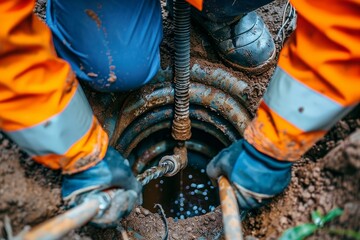Your septic system helps sort your household waste, with solids sinking to the bottom of the tank, grease floats to the top, and water in the middle. But without routine septic tank pumping, the sludge layer accumulates and clogs your drain field.
Regular pumping reduces the risk of sewage backups, which extends the lifespan of your drain systems and protects the environment. Visit https://septic-guys.com/ to learn more.
Septic systems are on-site wastewater treatment structures that rely on nature and helpful bacteria to process household waste. They remove solid matter from the wastewater and send it to a soil absorption field, where natural filtration and helpful bacteria continue to treat it before it enters groundwater. This tank-and-drain field combination is typically relied upon by households located in rural areas with no access to centralized sewer systems.
A septic tank looks like a large concrete box with one or more chambers. Heavy solid materials sink to the bottom of the tank forming a layer called sludge. Lighter fats, oils and other floatable materials form a layer on top known as scum. In the middle is a clear liquid waste called effluent. Bacteria living inside your septic system break down the organic solids in these layers into smaller components. This biological process partially treats the sewage, reducing its organic content. The septic tank also protects the drain field from premature clogging and failure by removing large debris from the wastewater before it reaches it.
The wastewater leaves the septic tank through a series of perforated pipes buried in the soil. As it seeps through the ground, the soil acts as a physical and biological filter, removing disease-causing pathogens, toxic organics and other impurities from the effluent before it is absorbed into the groundwater.
Depending on the size of your tank, household size and usage patterns, it can take between two to five years for a septic tank to reach its full capacity. Having your septic tank pumped at least every three to five years is recommended, as it helps prevent overflow and backup issues.
When you need to have your septic tank pumped, it is important to have it done by a licensed professional. Never attempt to pump your septic tank yourself. This can damage your tank and your septic system, and can cause pollution of the environment. Whenever possible, have your septic tank pumped from the large service port in the center of the tank, rather than the inlet or outlet ports on the sides. Using the inlet and/or outlet ports to pump your septic tank can cause significant damage to baffles that restrain and redirect the flow of wastewater.
Pumping Schedules
The general recommendation is to have your septic tank pumped every three to five years. However, this varies between homes based on the size of the tank and water usage. Having your septic tank pumped regularly helps your system run properly, avoiding costly repair bills and maintaining the value of your home.
When wastewater flows into your septic tank, solid waste separates into sludge, scum, and effluent. The sludge layer settles at the bottom while the lighter scum floats on the top. Eventually, the scum layer will be broken down by bacteria and reabsorbed into the sludge layer. The cleaner water will flow out of the septic tank into the drainfield, where it will be distributed throughout the drainage field network.
Keeping the septic tank pumped prevents sludge and scum from building up too high, which can clog pipes or overflow into the drainfield, potentially contaminating groundwater. This is also important for your health and safety, as contaminated water could enter your home or business and expose you to disease-causing organisms.
In some cases, a full tank may not cause immediate problems, but continued neglect can lead to septic system failure in the long term. Over time, the septic system will no longer be able to effectively treat sewage, which can overflow into the drainfield and create clogs. It is also possible that the septic tank can fail completely and need to be replaced, creating a costly and hazardous situation.
Maintaining a consistent pumping schedule will ensure that the septic tank is always at or near capacity, which reduces the risk of overflow and clogs. It will also help to avoid any unpleasant odors in the home and potential contamination of nearby water sources.
While there are many factors that affect the frequency of septic tank pumping, a good rule of thumb is to have it pumped when the sludge level reaches 14 inch or the scum layer reaches 34 inch. It is also a good idea to have your septic tank pumped in the spring or summer, which is when it is likely to be used more often due to seasonal higher water consumption.
Safety Measures
Septic tanks are large pieces of equipment that require specialized knowledge and equipment to operate. If not properly inspected, maintained and pumped, they can be dangerous to the people and property around them. This is why it’s so important to hire a reputable, licensed septic tank service provider for regular inspections, maintenance and pumping services.
During the pumping process, it’s important to keep children and pets away from the area. This is to ensure they don’t get exposed to harmful bacteria, gases or any other contaminants. In addition, if they accidentally fall into the septic tank, they could be seriously injured or even killed.
Another safety measure is to wear protective gear when handling sewage. This includes wearing gloves and a mask to prevent contact with any potentially dangerous bacteria. It’s also important to ensure any tools that come into contact with sewage are properly sanitized.
The last safety measure is to check that the septic tank and drain field are properly fenced or secured. This is to ensure that animals and children don’t wander into the area and get contaminated by sewage.
Keeping up with regular septic tank pumping is the best way to ensure your home’s septic system stays in good condition. If you notice frequent backups in sinks, toilets or tubs; unpleasant odors coming from drains or the surrounding yard; or pooling water or wet spots in your yard, schedule a septic tank pumping as soon as possible.
It’s also a good idea to have your septic tank service provider inspect the system for any other problems that may need to be repaired. This will save you money in the long run, as it can prevent costly repairs down the road. Finally, be sure to avoid using any septic tank additives. Research has shown that they don’t improve septic system performance and can actually cause more harm than good.
Contact Us
Your septic tank is an essential part of your home’s drainage system. It’s a costly component to replace, so you need to keep it functioning as effectively as possible to avoid clogs, backups, and other costly problems. Fortunately, you can do just that by keeping it pumped regularly.
Septic tank pumping removes the accumulated sludge layer from your septic tank and prevents it from overflowing into the drain field, which could cause costly damage. This routine maintenance also extends the life of your septic system and helps protect your family’s health.
Once the septic tank pumping company arrives, the crew locates and opens the access lid to your septic tank. If the lid is buried, they use a metal detector to find it. After removing it, they check for signs of damage or other issues with the septic system that could require repairs or replacement.
Next, they start the pumping process by using a high-powered hose connected to their truck’s vacuum pump. This sucks out the solid waste, liquid, and scum from the tank into their truck’s holding tank. The septic tank is then emptied and hauled to a disposal site for proper processing and disposal according to regulations.
Before the service crew leaves, ask them to inspect your septic system for any broken baffles or tees. If you have any, make sure they’re repaired as soon as possible to prevent wastewater from flowing into the tank instead of out through the septic system.
You can further reduce the frequency of septic tank pumping by upgrading to water-saving fixtures and appliances, such as low-flow toilets and showerheads, washing machines, dishwashers, and refrigerators. You can also educate household members on proper septic system usage to minimize the need for frequent pumping, such as limiting water usage and avoiding excessive waste disposal. Additionally, consider using septic system additives that promote bacterial activity to decompose waste more efficiently and reduce the amount of material that ends up in your tank.
